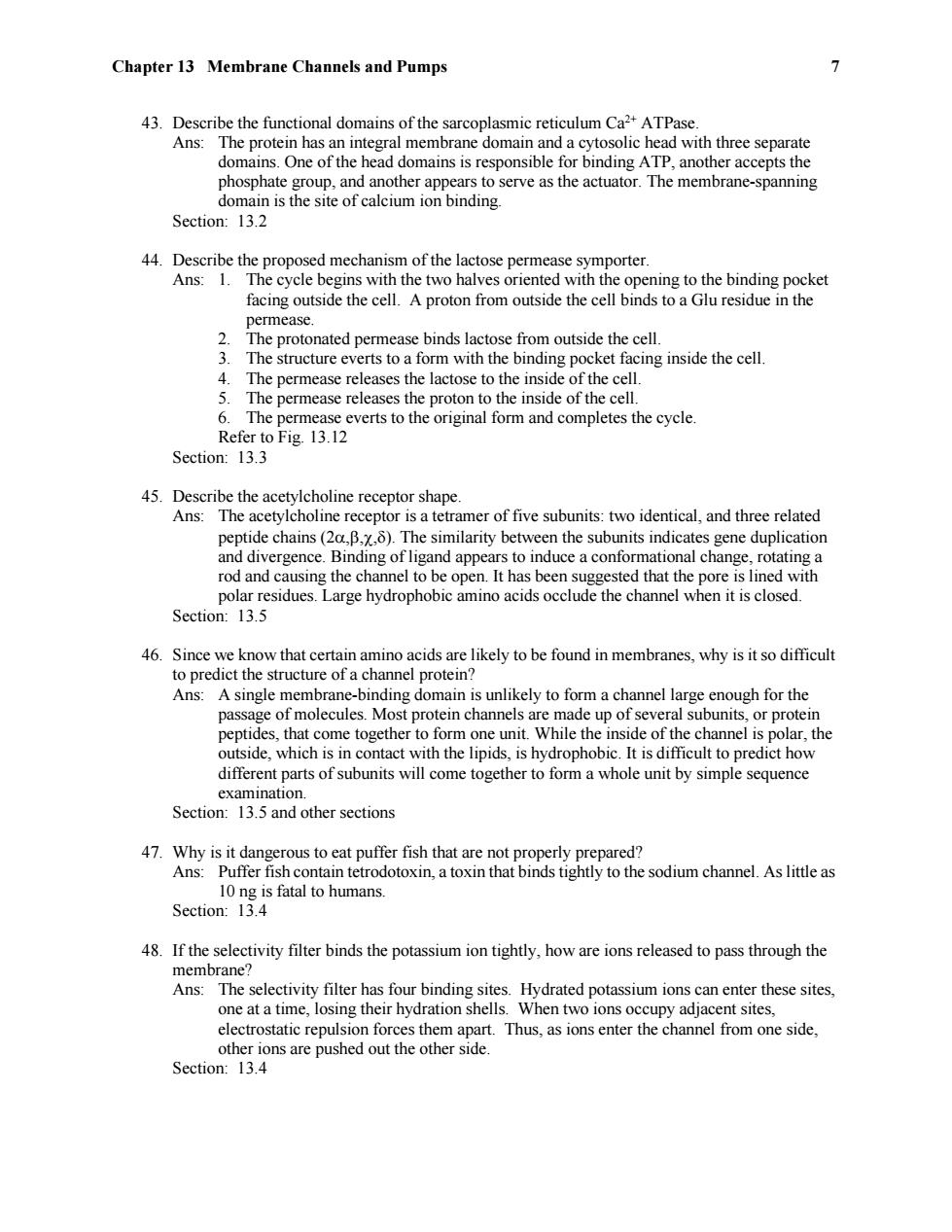正在加载图片...

Chapter 13 Membrane Channels and Pumps 7 43.Describe the functional domains of the sarcoplasmic reticulum Ca2+ATPase. Ans:The protein has an integral membrane domain and a cytosolic head with three separate domains.One of the head domains is responsible for binding ATP,another accepts the phosphate group,and another appears to serve as the actuator.The membrane-spanning domain is the site of calcium ion binding. Section:13.2 44.Describe the proposed mechanism of the lactose permease symporter. Ans:1.The cycle begins with the two halves oriented with the opening to the binding pocket facing outside the cell.A proton from outside the cell binds to a Glu residue in the permease. 2. The protonated permease binds lactose from outside the cell. 3.The structure everts to a form with the binding pocket facing inside the cell. 4.The permease releases the lactose to the inside of the cell 5.The permease releases the proton to the inside of the cell. 6.The permease everts to the original form and completes the cycle. Refer to Fig.13.12 Section:13.3 45.Describe the acetylcholine receptor shape. Ans:The acetylcholine receptor is a tetramer of five subunits:two identical,and three related peptide chains(2a,B,x,8).The similarity between the subunits indicates gene duplication and divergence.Binding of ligand appears to induce a conformational change,rotating a rod and causing the channel to be open.It has been suggested that the pore is lined with polar residues.Large hydrophobic amino acids occlude the channel when it is closed. Section:13.5 46.Since we know that certain amino acids are likely to be found in membranes,why is it so difficult to predict the structure of a channel protein? Ans:A single membrane-binding domain is unlikely to form a channel large enough for the passage of molecules.Most protein channels are made up of several subunits,or protein peptides,that come together to form one unit.While the inside of the channel is polar,the outside,which is in contact with the lipids,is hydrophobic.It is difficult to predict how different parts of subunits will come together to form a whole unit by simple sequence examination. Section:13.5 and other sections 47.Why is it dangerous to eat puffer fish that are not properly prepared? Ans:Puffer fish contain tetrodotoxin,a toxin that binds tightly to the sodium channel.As little as 10 ng is fatal to humans. Section:13.4 48.If the selectivity filter binds the potassium ion tightly,how are ions released to pass through the membrane? Ans:The selectivity filter has four binding sites.Hydrated potassium ions can enter these sites, one at a time,losing their hydration shells.When two ions occupy adjacent sites, electrostatic repulsion forces them apart.Thus,as ions enter the channel from one side, other ions are pushed out the other side. Section:13.4Chapter 13 Membrane Channels and Pumps 7 43. Describe the functional domains of the sarcoplasmic reticulum Ca 2+ ATPase. Ans: The protein has an integral membrane domain and a cytosolic head with three separate domains. One of the head domains is responsible for binding ATP, another accepts the phosphate group, and another appears to serve as the actuator. The membrane-spanning domain is the site of calcium ion binding. Section: 13.2 44. Describe the proposed mechanism of the lactose permease symporter. Ans: 1. The cycle begins with the two halves oriented with the opening to the binding pocket facing outside the cell. A proton from outside the cell binds to a Glu residue in the permease. 2. The protonated permease binds lactose from outside the cell. 3. The structure everts to a form with the binding pocket facing inside the cell. 4. The permease releases the lactose to the inside of the cell. 5. The permease releases the proton to the inside of the cell. 6. The permease everts to the original form and completes the cycle. Refer to Fig. 13.12 Section: 13.3 45. Describe the acetylcholine receptor shape. Ans: The acetylcholine receptor is a tetramer of five subunits: two identical, and three related peptide chains (2,,,). The similarity between the subunits indicates gene duplication and divergence. Binding of ligand appears to induce a conformational change, rotating a rod and causing the channel to be open. It has been suggested that the pore is lined with polar residues. Large hydrophobic amino acids occlude the channel when it is closed. Section: 13.5 46. Since we know that certain amino acids are likely to be found in membranes, why is it so difficult to predict the structure of a channel protein? Ans: A single membrane-binding domain is unlikely to form a channel large enough for the passage of molecules. Most protein channels are made up of several subunits, or protein peptides, that come together to form one unit. While the inside of the channel is polar, the outside, which is in contact with the lipids, is hydrophobic. It is difficult to predict how different parts of subunits will come together to form a whole unit by simple sequence examination. Section: 13.5 and other sections 47. Why is it dangerous to eat puffer fish that are not properly prepared? Ans: Puffer fish contain tetrodotoxin, a toxin that binds tightly to the sodium channel. As little as 10 ng is fatal to humans. Section: 13.4 48. If the selectivity filter binds the potassium ion tightly, how are ions released to pass through the membrane? Ans: The selectivity filter has four binding sites. Hydrated potassium ions can enter these sites, one at a time, losing their hydration shells. When two ions occupy adjacent sites, electrostatic repulsion forces them apart. Thus, as ions enter the channel from one side, other ions are pushed out the other side. Section: 13.4